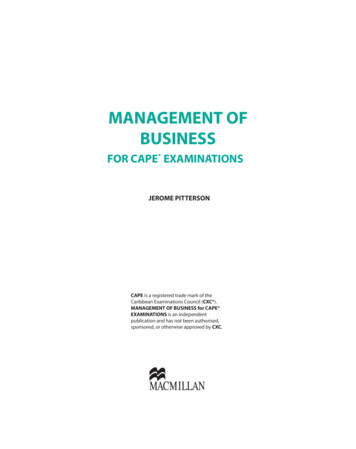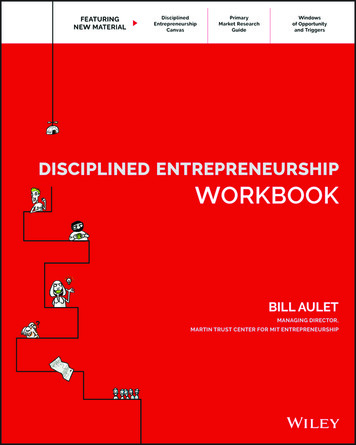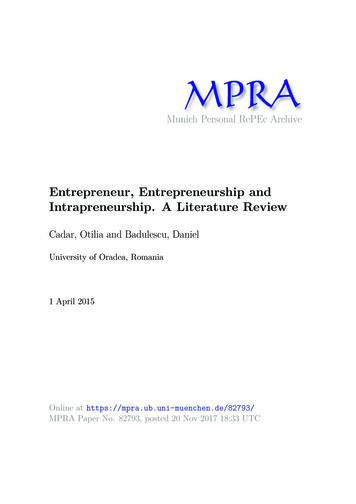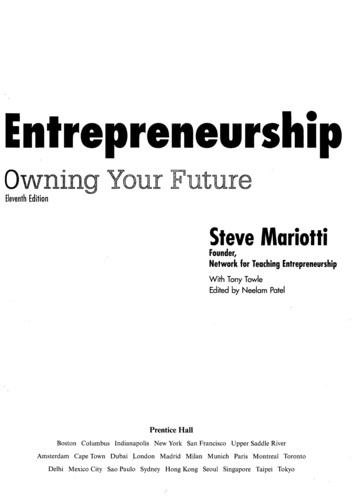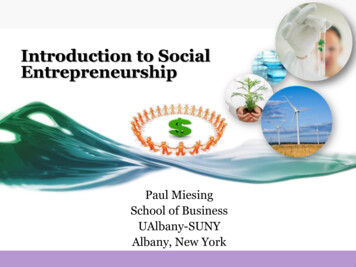
Transcription
Introduction to SocialEntrepreneurshipPaul MiesingSchool of BusinessUAlbany-SUNYAlbany, New York
Learning Objectives To understand the economic considerations, particularly marketfailures, that make social entrepreneurship desirable and necessary To recognize why governments are sometimes unable to solve socialand/or environmental problems To understand why private businesses are sometimes unwilling toaddress social and/or environmental problems To become familiar with the relatively recent developments thatmake social entrepreneurship possible To understand the characteristics of social entrepreneurship thatposition it as a powerful force for solving society’s problemsPaul Miesing, “Introduction to Social Entrepreneurship”
What’s the Problem? Increasing demands for social servicesoDisadvantaged groups throughout the world (individuals withdisabilities, convicts, homeless, individuals with substance abusehistories)oChronic un(der)employmentoMany emerging global problems (systemic poverty, HIV/AIDS,terrorism, repeated natural disasters) require immediate attention Costs of public services climbDecreasing availability of governmental and charitable fundsPaul Miesing, “Introduction to Social Entrepreneurship”
Market and Institutional Failures Arthritic “Invisible Hand” – Neoclassical economists’ self-correctingfree markets have no incentive to correct considerable economic andsocial harm Where’s Washington, DC? – Inconsistent governmental andinstitutional attempts to address societal problems, compounded byinadequate resources, lack of political will, endemic corruption, andconflicting political ideologies Widening Wealth Gap – Increasing polarization and breakdown ofcivil society through social disparity and economic stratification; i.e.,the top 1%Paul Miesing, “Introduction to Social Entrepreneurship”
Muhammad Yunus’ Story His observations in a Bangladesh village in 1974:Craftspeople were skilled but limited by credit availability The opportunity he saw: Micro-loans, with no collateral andlow interest, could improve their lives The results: Very high loan repayment; Creation of theGrameen Bank; Nationwide adoption The recognition: Professor Yunus won the 2006 Nobel PeacePrize; Grameen is a famous model of Social EntrepreneurshipPaul Miesing, “Introduction to Social Entrepreneurship”
So, What’s the Solution? Reduce poverty through creating jobsDevelop community trust and strengthen local networksMake communities self-sufficient, self-esteem, self-worth, andconfident Increase tax base to support servicesCreate markets for products produced locally rather thanimporting them Retain local wealth as the newly-employed both buy andspend morePaul Miesing, “Introduction to Social Entrepreneurship”
Creativity and Innovation:Schumpeter’s types of creative destruction Offer new product or serviceDevelop new process or technology for producing ordelivering an existing product, service, program or project Deliver existing product, service, program, or project to a newor previously underserved market Use new source of supply of raw materials and resourcesDesign organization structureUtilize new source of labor or other production inputsCreate new funding modelsPaul Miesing, “Introduction to Social Entrepreneurship”
EntrepreneurshipStagesOpportunity Recognition Social problems Unmet needsGoal Attainment Success Next steps?Concept Development Identifying social rewards New products/marketsScale and Sustain Expand and changeResource Requirement Land, labor, capitalLaunch Determine metrics Measure resultsPaul Miesing, “Introduction to Social Entrepreneurship”
A Modern Approach to Creating Social Value Greater global prosperity has made more wealth available for financingsocial ventures More free societies are interested in correcting social and environmentalwrongs outside of government and the business sector New communications technology has increased awareness of globalsocietal problems and their impacts Increases in formal education and college-educated individuals hasheightened social awareness Removing obstacles to participation of women and certain subjugatedgroups in societal affairsPaul Miesing, “Introduction to Social Entrepreneurship”
Why Use Social Entrepreneurship?It is passionateand personal to the socialentrepreneurIt is mission-focused,not profit-driven, thatreflects its valuesIt is not bureaucratic butnimble, moving quicklyIt is accountableto society, not privateshareholdersIt transforms, resulting insystemic change that yieldslong-term benefitsIt builds, maintains, andutilizes social capital bynetworking for tionsIt facilitates developmentby being equitable,enhancing social stabilityPaul Miesing, “Introduction to Social Entrepreneurship”It fosters social andenvironmental innovationto solve problemsIt circumnavigates politicsby taking a businessapproach
Persistent Social Entrepreneurship Concepts Inherent Disadvantages:o Government control or public scrutiny, budget constraints, lack financial resourcesOrganization Mission:oMust have a strong emphasis on a social missionoAddress social problems or needs not met by private markets or governmentProfits not a Dirty Word:oCombine social purpose with financial sustainabilityoMust be self-sufficient in spite of inherent disadvantagesWorks with Market Forces:oInnovative solutionsoPrivate actionPaul Miesing, “Introduction to Social Entrepreneurship”
Case Analysis: What Is It? Assimilate informationoProvides you with experience not ordinarily availableoIllustrates the theory and content of social entrepreneurship Top-management perspective CommunicatingoOffers an opportunity to participate in class and present your ideas toothersPaul Miesing, “Introduction to Social Entrepreneurship”
Case Analysis: Preparing a Case Study1.oo2.oo3.oo4.ooAssessment: Know what questions to askWhat’s the business model, problem, etc.?Examine key indicators of strategic and financial performanceAnalyze the current situationConduct financial, organizational, environmental analysisRead the conceptual material – How does it help (or not) understandthe case?Actions: RecommendationsSynthesize, integrate, and applySupport with reason and evidenceAppreciation: Learnings and takeawaysDe-briefRemaining questions or issues?Paul Miesing, “Introduction to Social Entrepreneurship”
Conclusions Massive social and economic problems defy conventional solutionsPopularity of social entrepreneurship is using free markets to createsocial value Entrepreneurs get things done in spite of obstacles and inherentdisadvantages by innovating and being creative Social entrepreneurs are accountable to the public, not onlyinvestors For more information and sources, ul Miesing, “Introduction to Social Entrepreneurship”
Course Purpose Summarize key principles of social entrepreneurshipIdentify the challenges and opportunities of socialentrepreneurship Use evidence to analyze, evaluate, and exploit a socialopportunity for an entrepreneurial venture Apply business functions to create and sustain a socialventure Prepare a business plan for a social enterprisePaul Miesing, “Introduction to Social Entrepreneurship”
Questions?Paul Miesing, “Introduction to Social Entrepreneurship”
Paul Miesing, “Introduction to Social Entrepreneurship” To understand the economic considerations, particularly market failures, that make social entrepreneurship desirable and necessary To recognize why governments are somet
